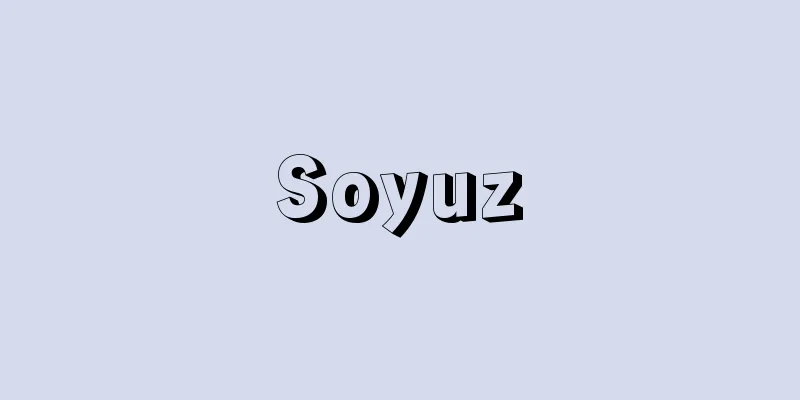Soyuz

|
A series of large manned spacecraft launched by Russia since 1967 during the Soviet era. No. 1 (April 1967, weighing over 30 tons) orbited the Earth 18 times but failed to land, and astronaut Komarov died. No. 3 (October 1968) rendezvoused with the unmanned No. 2, and No. 4 (January 1969) successfully docked with the manned No. 5. In October 1969, Nos. 6, 7, and 8 flew in formation, and No. 6 in particular succeeded in conducting a metal welding experiment in zero weight and vacuum. No. 10 (April 1971) docked with the previously launched Salyut, but the crew did not transfer and returned to Earth. No. 11 (June 1971) docked with Salyut and three crew members transferred on board, conducting the first manned orbital science station experiments, including a space garden and medical experiments, and recorded about 570 hours in space. However, the crew died when the spacecraft failed to keep airtight during the return flight. From then on, only the two-seater Soyuz was used until the 40th Soyuz was launched in May 1981, sending 77 astronauts, including foreigners, into space, and breaking the record for space stays on Salyut one after another. In 1975, it also docked with the American Apollo spacecraft. The Soyuz T was a new three-seater spacecraft that was an improved version of the Soyuz. It was first launched unmanned in 1979, and the T10, launched in February 1984, transferred to Salyut 7 and set a space stay record of 238 days. From 1986, the further improved Soyuz TM was adopted, and in 1990, Toyohiro Akiyama (then TBS), the first Japanese astronaut, flew to and from the space station Mir on this spacecraft. Furthermore, in 1995, the Soyuz TM21, carrying an American astronaut on board, docked with Mir, marking the first joint US-Russian space flight in 20 years, following the end of the Cold War. In 1997, a Soyuz transport ship carrying experimental equipment from the National Space Development Agency of Japan was launched for the first time, marking a new attempt between the two countries. Soyuz means "union" or "alliance" in Russian. → Related topics Spaceships Source : Heibonsha Encyclopedia About MyPedia Information |
|
ロシアがソ連時代の1967年から打ち上げている一連の大型有人宇宙船。1号(1967年4月,重量30t以上)は地球を18周したが着地に失敗,飛行士のコマロフは死亡。3号(1968年10月)は無人の2号とのランデブー飛行に,4号(1969年1月)は有人の5号との間のドッキングに成功。1969年10月,6,7,8号の3船の間で編隊飛行を行い,特に6号では無重量・真空状態での金属溶接実験に成功。10号(1971年4月)は,先に打ち上げられたサリュートとドッキングしたが乗員は移乗せず,地球に帰還。11号(1971年6月)はサリュートとドッキングして乗員3人が移乗,宇宙菜園,医学実験など初の有人軌道科学ステーションの実験を行い,宇宙滞在約570時間を記録した。しかし乗員は帰還時,宇宙船の気密保持ができず死亡。以後2人乗りのソユーズのみが1981年5月打上げの40号まで使われ,外国人を含め77人の宇宙飛行士を宇宙に送り,次々とサリュートでの宇宙滞在の記録を更新した。なお,1975年にはアメリカのアポロ宇宙船とのドッキングも行った。ソユーズTはソユーズを改良した新しい3人乗り宇宙船で,1979年無人で打ち上げられたのを最初に,1984年2月打上げのT10ではサリュート7号に移乗,238日の宇宙滞在記録を打ち立てた。1986年からは,さらに改良されたソユーズTMが採用され,1990年に日本人初の宇宙飛行士となった秋山豊寛(当時TBS)が宇宙ステーション・ミールと往復したのもこの宇宙船。さらに1995年には米人飛行士も乗り組んだソユーズTM21がミールとドッキング,冷戦終結を受けて20年ぶりに米ロ合同宇宙飛行が行われた。また日本との間でも,1997年に初めて宇宙開発事業団の実験装置を積んだソユーズ輸送船が打ち上げられるなど新たな試みがなされた。ソユーズはロシア語で〈結合〉あるいは〈同盟〉の意。 →関連項目宇宙船 出典 株式会社平凡社百科事典マイペディアについて 情報 |
<<: Soyurghāl (English spelling)
Recommend
Iseut
...The protagonist of a love legend that was wide...
Viola thibaudieri (English spelling) Viola thibaudieri
… [Yukio Taniguchi]. … *Some of the terminology t...
Aquilaria agallocha (English spelling) Aquilariaagallocha
...High-quality agarwood has a high specific grav...
Kamigayatsuri - Kamigayatsuri
→Papyrus Source : Heibonsha Encyclopedia About MyP...
Geumgwan-gaya - from kumquat
…A powerful state among the ancient Korean states...
Cerebral arteriosclerotic psychosis
A disease that occurs as a result of cerebral circ...
Percier, Charles
Born: August 22, 1764 in Paris Died: September 5, ...
Aluminum hydroxide - aluminium hydroxide
Aluminium hydroxide. Chemical formula: Al(OH) 3 ,...
Oxazolone
[Synonym] Azlactone Source: Morikita Publishing &...
standing committee
...In addition, because party discipline is weak ...
"Ishida Tsume Shogi Gunbai"
...However, since it was not permitted to dramati...
Nagisa Oshima
Film director. Born March 31, 1932 in Yoshida-cho...
Viceroyalty - virreinato [Spain]
The Kingdom of Aragon was a unique federal state i...
"Ekiyoyakuroku"
…In addition to the “Interpretation of the Yi Ton...
Fish Highway - Uokaido
…The Wakasa Highway runs through the valley of th...









